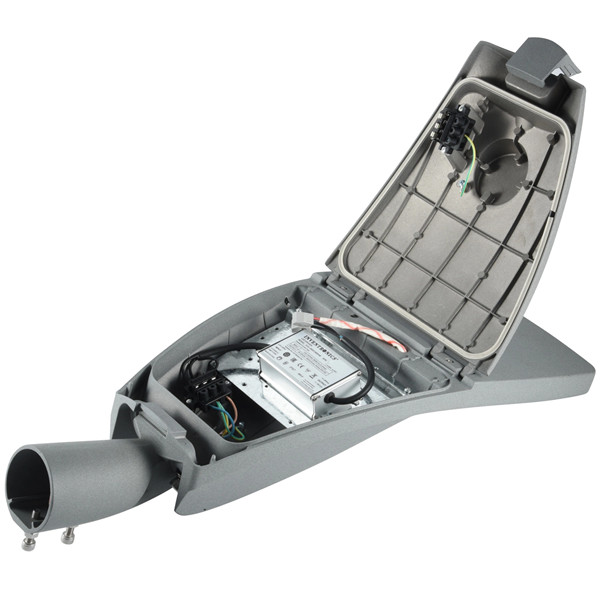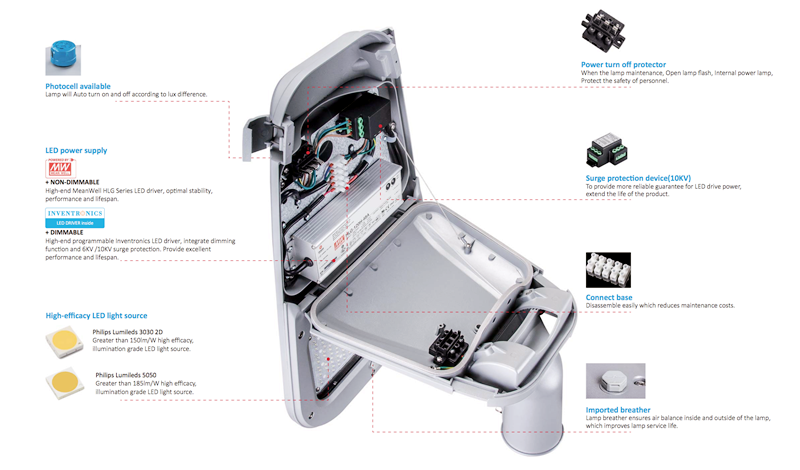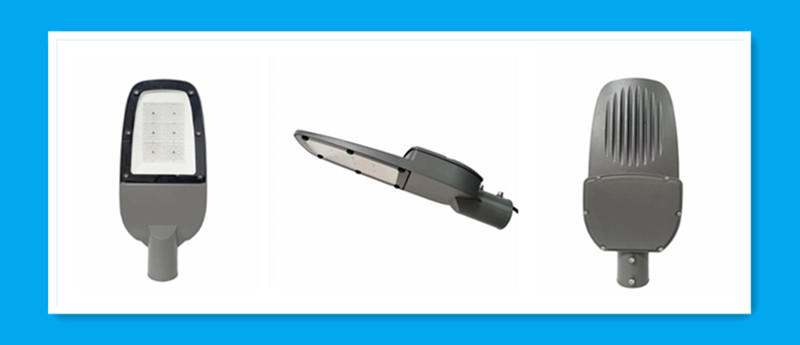This article primarily focuses on the application of various LED street lights, proposes a suitable architecture, and analyzes their advantages and disadvantages. The goal is to assist readers, including lighting dealers, lighting engineering companies, lighting experts, and lighting purchasers, in making informed decisions based on specific conditions and design requirements to find the most suitable street lighting solution.
Traditional street lighting has traditionally utilized high-pressure sodium lamps (HPS) or mercury vapor lamps (MH), both of which feature mature technology. However, in comparison to these conventional options, LED lighting boasts several inherent advantages.
Low Consumption: Research data indicates that street lighting typically accounts for approximately 30% of a city's municipal energy budget. The low energy consumption characteristics of LED lighting can alleviate this significant energy expenditure. It is estimated that the global adoption of LED street lights can lead to a reduction of several million tons in carbon dioxide emissions.
Excellent Directionality: Traditional road lighting sources lack directionality. This can result in inadequate lighting brightness in crucial areas and cause light to scatter into unnecessary zones, leading to light pollution. LED lights offer excellent directionality, addressing these issues by illuminating specific spaces without affecting the surroundings.
High Luminous Efficiency: LED light sources outperform high-pressure sodium or mercury vapor bulbs in terms of luminous efficiency. They can produce more lumens per unit of power consumption. Moreover, LED lights emit considerably lower levels of infrared (IR) and ultraviolet (UV) light compared to traditional sources, resulting in less waste heat and reduced thermal stress on the fixtures.
Longevity: LEDs are well-known for their high operating junction temperature and extended lifespan. In road lighting applications, LED lighting arrays can have a service life of 50,000 hours or more, which is two to four times longer than that of high-pressure sodium or metal halide lamps. This longevity eliminates the need for frequent replacements, leading to substantial savings in materials and maintenance costs.
Environmental Friendliness: High-pressure sodium lamps and mercury vapor lamps contain toxic substances, such as mercury, necessitating special disposal procedures that are time-consuming and environmentally unfriendly. In some instances, metal halide lamps can even pose safety hazards due to the risk of explosions. In contrast, LED lamps do not exhibit these issues, making them more environmentally friendly and safer to use.
Enhanced Control: LED street lights offer highly controllable driving methods that convert AC/DC and DC/DC power supplies into the voltage and current required for LED operation. While this may increase circuit complexity, it enhances controllability and responsiveness compared to traditional AC lighting technology. This enables features such as rapid switching and dimming. Additionally, precise control over LED color temperature can be achieved through component selection. Improved controllability is a crucial factor in achieving automated intelligent lighting, making LED street lights essential for smart city development.
In summary, LED street lighting offers outstanding advantages that have led to the replacement of traditional street lights. Various designs of LED street light power supplies are available on the market. While early designs focused on cost-efficiency, there is now a growing consensus that prioritizes high efficiency and reliability.

An LED street light driver, in simple terms, is a power converter. Its primary function is to transform standard mains power or other power sources into the appropriate voltage and current required for LED operation. Through this conversion process, LEDs can function properly and emit light. To draw an analogy, just as a specific type of wrench is required to loosen a nut, an LED driver ensures that the LED operates effectively by providing the necessary electrical parameters.

There are two main categories of LED drivers: digital technology drivers and analog technology drivers.
Digital technology drivers involve the use of digital circuits to generate driving signals. This category includes digital dimming control and features like RGB full-color variations.
Analog technology drivers, on the other hand, utilize analog circuits for driving LEDs. This category includes AC/DC constant current switch-mode power supplies and DC/DC constant current control circuits.
LED driver circuits are primarily composed of electronic components, including semiconductor devices, resistors, capacitors, inductors, and more. All these components have finite lifespans, and the failure of any single component can lead to the malfunction of the entire circuit or the partial loss of functionality.
The theoretical lifespan of LEDs is typically between 50,000 to 100,000 hours. For instance, at 50,000 hours, if LEDs are continuously illuminated for 8 hours every day, they would last for nearly 6 years. However, achieving an 8-year lifespan with LED drivers is challenging. Most commercially available LED drivers come with warranties of around 2 to 3 years. LED drivers capable of reaching a 6-year warranty period are considered military-grade and are priced 4 to 6 times higher than standard drivers. Such premium options are generally not feasible for most lighting manufacturers to use. Therefore, many LED lighting fixture failures are attributed to issues with the driver circuits.
There are two main circuit topologies for LED streetlight driver power supplies: the flyback topology and the LLC (LCC) topology. The flyback topology is suitable for power levels generally below 150W. For LED streetlight power supplies below 150W, the commonly used topology is the half-bridge LLC circuit.
The characteristics of a 30W LED streetlight driver power supply based on the FAN7554 are as follows:
The primary application for a 30W LED streetlight is in localized roadways, garden paths, courtyard roads, residential communities, and similar areas. Due to the relatively low output power, the overall cost of the fixture is lower. While the LED driver constitutes a relatively small portion of the total cost structure of the streetlight, it is still essential to consider circuit cost during the design phase.
In terms of circuit structure, if a single-chip MOSFET and PWM controller are integrated into the same chip to form a single-chip switch-mode power supply integrated circuit, the peripheral components are reduced, simplifying production. Compared to a discrete circuit with a control chip and separate MOSFET, this integrated solution saves approximately 3 to 5 Chinese yuan in component costs. These savings represent pure profit for LED driver manufacturers. As a result, the 30W LED streetlight driver, considering circuit structure and cost factors, adopts Fairchild Semiconductor's FAN7554 in combination with a power MOSFET to create a single-stage flyback PFC+DC/DC conversion circuit.
Two significant trends in LED street lighting warrant our attention. The extensive adoption of LED lighting in urban road illumination represents a significant trend. However, it's crucial to recognize that this technological transition is not merely a straightforward "replacement" of traditional lighting equipment; rather, it signifies a comprehensive transformation. Within this transformative process, two notable trends have emerged that demand our focus.
One of these developmental trends pertains to intelligence. As previously mentioned, LED lights are highly controllable, offering the potential to establish automated intelligent street lighting systems. In these systems, precise algorithms and even machine learning capabilities, informed by environmental data (such as ambient light levels, human and vehicular presence, etc.), facilitate the automatic adjustment of street light operation without manual intervention. The advantages of such systems are self-evident. Serving as a network encompassing urban infrastructure, street lights themselves may evolve into more intelligent edge nodes within the Internet of Things. In the future, it might be possible to incorporate additional functions into LED street lights, such as weather and air quality monitoring, enhancing their utility in smart cities and expanding their roles.
However, it is worth noting that this trend towards intelligence will also present new challenges in LED street light design, given that the systems will grow increasingly complex. With limited physical space for street light fixtures, the need arises to accommodate not only lighting and power-related functions but also sensing, control, communication, and more extended capabilities. To confront this challenge, standardization emerges as the sole viable solution and currently represents another crucial trend in LED street lighting. The advantage of standardization lies in its capacity to facilitate the seamless integration of functional modules from various technology suppliers with LED street lights, considerably enhancing the system's scalability.
Intelligence propels standardization, and, reciprocally, standardization drives the deepening of intelligence. The interplay between these two trends propels the continuous evolution of LED street lighting technology and its applications.

We hope this article proves valuable to you. We greatly appreciate your interest in our company and our unwavering commitment to delivering top-tier LED street lighting solutions. Today, we are thrilled to introduce the LED Street Light Buyer’s Guide, a resource that sets us apart from the competition.
In today's world, where efficient and sustainable urban lighting is more vital than ever, making the right choice for your LED street lighting investment is paramount. Our dedication to excellence and professionalism has driven us to create this comprehensive guide, specifically designed to empower you with the knowledge and insights necessary for well-informed decisions.
Here's what distinguishes our presence in the LED street lighting industry:
Professional Expertise and Experience: Our team is composed of seasoned professionals with extensive experience in LED lighting technology. We've pooled our collective knowledge into this guide to ensure that you benefit from insights provided by true industry experts.
Tailored Solutions: We understand that every lighting project is unique. Our guide is crafted to assist you in customizing your LED street lighting selection to precisely match the unique requirements of your project, ensuring optimal performance and energy efficiency.
Cutting-Edge Technology: We consistently remain at the forefront of the LED lighting industry. Our guide reflects the latest advancements and trends, providing you with a competitive edge when selecting the most innovative and efficient solutions.
Sustainability: As strong advocates of sustainability, we emphasize environmentally friendly options and offer information on how LED street lights can reduce energy consumption and carbon footprints.
Cost-Effective Choices: In today's competitive market, cost considerations are pivotal. Our guide provides valuable insights into cost-effective LED street lighting options that never compromise on quality or performance.
Customer-Centric Approach: At our company, your satisfaction is our priority. This guide has been meticulously designed with your needs in mind, offering clear, actionable guidance to simplify your decision-making process.
We invite you to leverage this invaluable resource to make the most well-informed choice for your LED street lighting project. Together, we can pave the way for more efficient, cost-effective, and sustainable urban lighting solutions.
For access to more resources, including the "LED Lighting Practitioner's Guide," please visit : https://www.lederlighting.com/Blog.html.
Thank you for considering us as your partner in achieving your lighting objectives. We eagerly anticipate the opportunity to collaborate with you, showcasing our distinctive professionalism and expertise.
Should you have any questions or require further assistance, please do not hesitate to contact us. Your satisfaction remains our utmost priority.
Contact: Mr. Otis
Phone: +8615815758133
Tel: +8615815758133
Email: Hello@lederlighting.com
Add: No. 1 Gaoxin West Road,High-tech Zone, Jiangmen, Guangdong, China